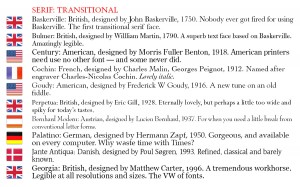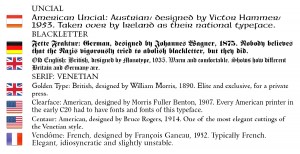The 100 Best Fonts: Serif Transitional
Monday, November 14th, 2016Click to enlarge.
SERIF: TRANSITIONAL
Baskerville: British, designed by John Baskerville, 1750. Nobody ever got fired for using Baskerville. The first transitional serif face.
Bulmer: British, designed by Willliam Martin, 1790. A superb text face based on Baskerville. Amazingly legible.
Century: American, designed by Morris Fuller Benton, 1918. American printers need use no other font — and some never did.
Cochin: French, designed by Charles Malin, Georges Peignot, 1912. Named after engraver Charles-Nicolas Cochin. Lovely italic.
Goudy: American, designed by Frederick W Goudy, 1916. A new tune on an old fiddle.
Perpetua: British, designed by Eric Gill, 1928. Eternally lovely, but perhaps a little too wide and spiky for today’s tastes.
Bernhard Modern: Austrian, designed by Lucien Bernhard, 1937. When you need a little break from conventional letter forms.
Palatino: German, designed by Hermann Zapf, 1950. Gorgeous, and available on every computer. Why bother with Times?
Jante Antiqua: Danish, designed by Poul Søgren, 1993. Refined, classical and barely known.
Georgia: British, designed by Matthew Carter, 1996. A tremendous workhorse. Legible at all resolutions and sizes. The VW of fonts.







